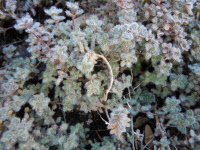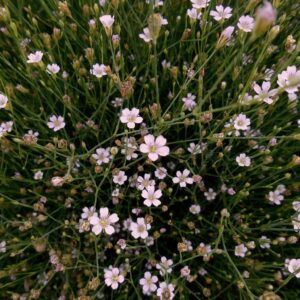Alpine, Rock, Miniature, Bonsai and Railroad Gardens
Showing 81–88 of 92 results
-
Symphyandra zanzegura syn Campanula zanzegura Ring bellflower, Rock bellflower Z 5-10
Flared lilac bells hang from wiry stems all summer. Self-sows.
OUT OF STOCK
Flared petal ends of lilac bells on wiry red stems over soft, velvety leaves persist much of summer.
Size: 15” x 15”
Care: full to part shade in moist well-drained soil
Native: mountains of Armenia, Eastern Europe
Wildlife Value: attracts beesDescribed and published by Ukrainian botanist Vladimir Lipsky (1863-1937) in 1894. Reclassified as a Campanula in 1980.
-
Synthyris missourica Mountain Kittentails Z 5-9
Spring flowering, true blue short stalks above leathery, evergreen leaves, circular with tooth margins.
OUT OF STOCK
Spring flowering, true blue short stalks above leathery, evergreen leaves, circular with tooth margins.
Size: 5-12” x 12” spreading into clumps by rhizomes.
Care: sun to part shade in moist to moist well-drained soil
Native: Mountains of northeast CA, Washington, Idaho & west to MontanaCollected by Meriwether Lewis on June 26, 1806 in today’s Idaho near the headwaters of what they named Hungry Creek. Common name kittentails imaginatively named for the flower stalk and its protruding stamens resembling, if you squint real hard and maybe after taking a swig of whiskey, fuzzy, blue kitten tails.
-
Talinum calycinum syn. Phemeranthus calycinus Rock rose, Fameflower Z 6-9
Bright mauve flowers dance on wiry stems in afternoons all summer, closing at night. Leaves are succulent.
Tender reseeding perennial, but they survived the horrible winter of 2013-14. In any event they reseed reliably. Just watch for little succulent leaves.
Bright mauve flowers dance on wiry stems in afternoons all summer, closing at night. Leaves are succulent.
Size: 8-12” x 4”
Care: Sun in well-drained soil
Native: western Plains statesCollected by Dr. Frederick Wislizenus on sandy soil near the Cimarron River on an exploring trip of Texas, New Mexico and Mexico in 1846. Wislizenus (1810-1889) was a German immigrant, explorer a, botanist and medical partner of George Engelmann (1809-1884) important promoter of plant-hunting and expert on cacti and conifers.
-
Thymus pseudolanuginosus Woolly thyme Z 4-8
Wonderful groundcover or in rock gardens for its miniature, very hairy silver leaves, resembling wool. Lavender flowers in June.
Grown as a groundcover or in rock gardens for its miniature, very hairy silver leaves, resembling wool. Lavender flowers in June.
Size: 1” x 12” spreading slowly
Care: sun to part shade in well-drained soil.
Native: Europe
Wildlife Value: Drought tolerant. Deer resistantThymus from the Greek word for “odor” due to the plant’s fragrance. Ancient Greeks made incense with thyme. This species 1st mentioned in Gardeners Dictionary by Phillip Miller of Chelsea Physic Garden fame, 1771.
-
Thymus serpyllum ‘Minus’ syn. T. praecox ‘Minus’ Dwarf thyme Z 4-8
Tiny-leaved, miniature thyme, lilac-colored flowers in early summer, used as a groundcover or for fairy gardens and rock gardens.
Tiny-leaved, miniature thyme, lilac-colored flowers in early summer, used as a groundcover or for fairy gardens and rock gardens.
Size: 2" x 6"
Care: sun to part shade in well-drained soil
Native: Europe
Wildlife Value: Deer resistant.
Size: Great for rock gardens, groundcover, drought tolerant.Thymus from the Greek word for “odor” due to the plant’s fragrance. Ancient Greeks made incense with thyme. ‘Minus’ described by Parkinson in 1640. He called it Thymus serphyllum vulgare minus.
-
Thymus serpyllum syn. Thymus praecox Mother-of-thyme, creeping thyme Z 4-9
Short purple spikes in June-July
Short purple spikes in June-July
Size: 3” x 24”
Care: sun in well-drained soil
Native: Europe & Western Asia
Size: groundcover, rock garden, herb, fragrant foliage, thyme lawnThymus from the Greek word for “odor” due to the plant’s fragrance. Ancient Greeks made incense with thyme. This species since at least 1753. Acc’d to Parkinson in 1640 this remedied hysterics in women. Wm. Robinson wrote,”nothing can be more charming than a sunny bank covered with” Thymus serpyllum. LH Bailey extolled it as “prized as an evergreen edging and as cover for rockwork and waste places …The leaves are sometimes used for seasoning.”
-
Tunica saxifraga syn. Petrorhagia saxifraga Tunic flower Z 4-8
Free blooming pixie, palest of pink blossoms from June through October on wiry stems form a 4" tall mound.
Free blooming pixie, palest of pink blossoms from June through October on wiry stems form a 4″ tall mound.
Size: 6" x 8"
Care: Full sun in well-drained soil.
Native: Pyrenees and Alps
Wildlife Value: Drought tolerant.
Awards: Royan Horticultural Society Award of Merit.
Size: Perfect for rock gardens, front of borders or groundcover.Tunica is Latin meaning tunic or coat referring to overlapping bracts beneath the flower. Before 1753. Near the turn of the century William Robinson described the Tunic flower as having “elegant little rosy flowers … a neat plant for the rock garden and fringes of borders and thrives like a weed between the stones in a rough stone wall.” “Suggestive of a miniature gypsophila.” H.H. Thomas, 1915.
-
Veronica armena Armenian speedwell Z 4-9
A peewee plant that packs a punch. In spring to early summer terminal clusters of cup-shaped Vermeer blue flowers made of 4 obovate, smooth-edged petals set off snow white eyes with matching white stamens. Below the floral crown forest-green, soft, needle-sized leaves frame the blue and detail texture for the rest of the season.
OUT OF STOCK
A peewee plant that packs a punch. In spring to early summer terminal clusters of cup-shaped Vermeer blue flowers made of 4 obovate, smooth-edged petals set off snow white eyes with matching white stamens. Below the floral crown forest-green, soft, needle-sized leaves frame the blue and detail texture for the rest of the season.
Size: 4” x 6” and spreading
Care: sun in well-drained soil
Native: Armenia, Georgia and TurkeyDiscovered before 1856 when it was named and described by Swiss explorer and botanist Pierre Edmond Boissier.








